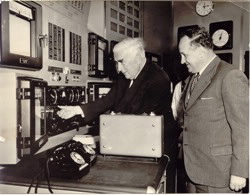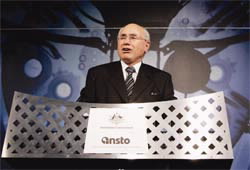 |
| Prime Minister Sir Robert Menzies officially opened HIFAR on 18th April 1958 |
Sixty years ago today, on April 15 1953, Federal Parliament passed the Atomic Energy Act –Australia’s first tentative step along a scientific path that led to the formation of one of our country’s leading public research organisations, which has benefited millions of people around the world.
What started out as the Australian Atomic Energy Commission (AAEC) in 1953 has evolved into The Australian Nuclear Science and Technology Organisation (ANSTO) and just like the FJ Holden, which was released in the same year, ANSTO has completely transformed since those early days of its inception.
Having long since moved on from nuclear power research, ANSTO today is a state-of-the-art scientific campus: home of the $460 million OPAL research reactor and the workplace for 1000 scientists, engineers and experts working in fields as diverse as medical and environmental research.
Today, one in two Australians benefit from nuclear medicines manufactured at ANSTO’s main campus at Lucas Heights, helping diagnose and treat heart disease, cancer, muscular and skeletal conditions. Broader benefits come from its advanced climate change and industrial research.
Staff at ANSTO will be marking 60 years of achievement throughout this week, particularly the one third of ANSTO employees who both live and work in the local area.
“ANSTO is one of Australia’s largest public research organisations. The research undertaken by ANSTO is both nationally significant and internationally recognised,” said Dr Greg Storr who lives in St George and works in ANSTO’s Nuclear Science and Technology Group.
“Local residents may not realise how significant ANSTO is to Australian science. Indeed ANSTO manages some of Australia’s most impressive tools for science, and attracts scientists from across Australia and the world.
“Make no mistake - the Sutherland Shire is an international centre of scientific excellence. An achievement, of which, we can all be proud.”
Jamie Schulz lives at Mortdale is the Operations Manager at ANSTO’s Bragg Institute, where scientists and engineers use neutron scattering and X-ray techniques to solve complex research and industrial problems for a range of companies and research organisations.
“Scientists from all over the world visit ANSTO to run unique experiments using the neutrons produced by OPAL, Australia’s only operating nuclear research reactor,” Dr Schulz said.
“Our experiments allow scientists to determine the atomic structure and understand the properties of materials leading to new discoveries and the development of innovative technologies.”
ANSTO’s Chief Executive Officer, Dr Adi Paterson, said that perhaps ANSTO’s most vital role is its contribution to the Australian medical system – creating and distributing 10,000 doses of nuclear medicine to 250 hospitals and medical centres a week.
“ANSTO was developed with a great pioneering spirit, a thirst for new knowledge and a deeper understanding of the potential of nuclear science and technology to deliver new answers for science and solutions for our industries,” Dr Paterson said.
 |
| Prime Minister John Howard opening the OPAL reactor in 2007. |
“Today ANSTO enables environmental scientists, biologists, geneticists, material scientists and many others to use nuclear techniques to inform their research and deliver new insights that are helping to address some of the big issues of our time, particularly surrounding health and climate change.
“ANSTO is much more than a research facility: we use nuclear technologies to support local industry, to produce 85 per cent of Australian nuclear medicines and serve the microelectronics and minerals industries globally.
“That medical role will be enhanced in coming years, thanks to the Federal Government’s recent announcement of $168 million to dramatically enhance Australia’s nuclear medicine capacity by building a new nuclear medicine manufacturing facility at ANSTO.
“I certainly am very proud to be part of an organisation of some 1000 staff that is benefiting the lives of all Australians, and applaud that group of Australian leaders back in 1953 and the many others over the years who have lead us to where we are today”.
Visit a special photo gallery highlighting some of the history of ANSTO, including images from famous Australian photographer Max Dupain.
Published: 15/04/2013

